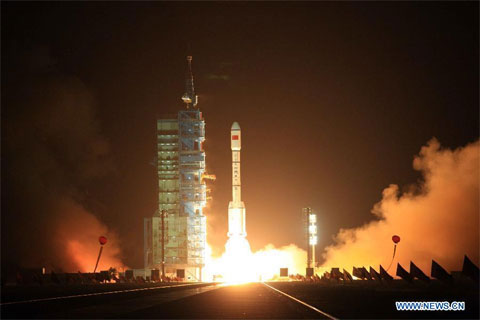China launched the first module for the space station
China yesterday successfully launched its first test module just before the country's national anniversary, in preparation for the construction of the space station.
>>>China is about to launch "Thien Cung"
Thien Cung-1 (Tiangong-1) was launched by Truong Chinh 2F boosters around 21h15 local time in the Gobi desert in northwestern China, AFP reported. The unmanned aerial module weighing about 8.5 tons will conduct a number of tests on space operations, as the first steps towards establishing a space station by 2020.
Chinese Premier Wen Jiabao was present at the Jiuquan Satellite Launch Center, Gansu Province, to monitor the process of bringing Tian-1 to orbit. Meanwhile, Chinese President Hu Jintao followed the process at a space flight control center in Beijing, Xinhua .

Thien Cung-1 was launched from the Tu Tuyen Satellite Launching Center. (Photo: Xinhua)
About 10 minutes after being launched, Thien Cung-1 successfully separated from the rocket at an altitude of about 200km, before opening its two solar panels.
China considers its ambitious space program a symbol of its global stature. The major Chinese newspapers spent many pages talking about the Tian-1 event for many days, and considered it an important milestone for the Eastern power.
Meanwhile, American experts appear to be quite reserved in response to the successful launch of China's unmanned module."Heavenly Palace-1 is the next step of China's slow but steady effort, in order to gain the ability to conduct human-made flights into space," Xinhua quoted John Logsdon, a policy expert. based at George Washington University. "The event itself is not a significant step forward, but it is really important for identifying Chinese meeting points and spacecraft connectivity technologies."
Thien Cung-1, which has a two-year life span in space, will receive the Shenzhou unmanned 8 spacecraft later this year, in what is considered to be China's first space connection. If this event succeeds, Thien Cung-1 will be assembled with two more spacecraft, including Than Chau IX and Than Chau X, in 2012. Both spacecraft will carry at least one house. Astronaut.
Connection in space is a technology that is not easy to master, since two assembled objects need to be combined slowly to avoid mutual damage, in terms of being placed in the same orbit and spinning around. Earth at a rate of about 28,000 km / hour.
The French researcher Isabelle Sourbes-Verger argues that a complete and accurate assembly system will help China get a great opportunity, to one day approach the International Space Station (ISS). However, Sourbes-Verger also cautiously judged that this could not happen within the next 5 years.
After significant progress in 30 years of rapid economic development, China has made significant strides in the space sector. In 2003, the country first brought its citizens into space, when the astronaut Duong Loi Vi and the Shenzhou 5 ship had a successful flight into space. If China successfully assembled space equipment later this year, they would have done what the US and Russia had previously achieved.
China aims to complete its first space station by 2020. That will be where astronauts can live and work for months, just like in ISS and Russia's Mir space station. China is also planning to bring people to the moon, but has not set a specific time for this.
- 2011: China launched the first module of the space station
- By 2022, China will have the first international space station
- China plans to launch Tiangong Space Station similar to ISS by 2020
- Shenzhou 10 and the space race
- China successfully tested the Module for the future Moon Station
- December 4, 1998 - The International Space Station receives the first module assembled by the United States
- China successfully launched Thien Cung 2 space station
- November 20, 1998 - The first module of ISS International Space Station flies into space
- China developed a project of a space station with people
- Russian space station will replace the US ISS global surveillance
- Overview of China's Thien Cung 1 Space Station
- China intends to operate the new space station in 2022
 Van Allen's belt and evidence that the Apollo 11 mission to the Moon was myth
Van Allen's belt and evidence that the Apollo 11 mission to the Moon was myth The levels of civilization in the universe (Kardashev scale)
The levels of civilization in the universe (Kardashev scale) Today Mars, the sun and the Earth are aligned
Today Mars, the sun and the Earth are aligned The Amazon owner announced a secret plan to build a space base for thousands of people
The Amazon owner announced a secret plan to build a space base for thousands of people